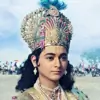Ughhh... of all the topics on this forum to hit soooo many pages, why did it have to be this one 😆 Was hoping the momentum from the retelecast would spur conversations that are either more substantive or more fun, but since this relatively minor point has already spurred so many posts, what's one more :P My thoughts on a few random things mentioned throughout the thread:
1) The show does NOT eliminate the line about using the deer skin as a prayer mat in some effort to promote a modern notion of goodness. The line is very much there (I know, it makes me--an animal lover--cringe every time!) watch from 31:40 where Ram asks Sita what she'll do if he can't catch the deer alive. Hearing her answer, he doesn't bat an eye so I think the show is pretty comfortable with it: https://youtu.be/oJUhgEYH1-I?t=1900
2) Whether it's the less conservative style of dress in Treta Yug or the acceptance/non-acceptance of animal killings, if we accept that those were the customs of the era, it doesn't make sense to refer to them as character flaws or shades of gray, or to refer to their (nonexistent) non-inclusion as white-washing.
3) I don't think you need to check 10 sources to rationalize what is, from a human perspective, a totally irrational demand. Whether she wanted it as a pet or for its skin is ultimately SUCH a minor point... from a human point of view, there is NO sensible reason to want your husband to go into a forest that's already proven to be demon-infested for the sake of a deer. If you consider her an ordinary woman unaware of her divine identity, you can either believe that it was a moment of childishness/foolishness OR a suspicion that this unnatural looking thing was a demon and a desire to have her husband (a certified demon slayer at this point 😎) investigate further. If you consider her fully aware of her divinity, then it's obviously all part of the plan to accomplish the objective of the incarnation, i.e. kill Ravan and halt the atrocities of demons on earth. Neither of those interpretations is affected in the slightest by her expressed motivation for wanting the deer.
4) To some extent, I agree that Maharishi Valmiki having been a contemporaneous author makes his rendition of events more likely to be closer to the truth. For the descriptions of things like the order in which battles occurred or who participated in them, I'd definitely go with what's in Valmiki Ramayan. However, I DON'T think this applies dialogues (e.g. this deer situation or even Agni Pariksha). Maharishi Valmiki did not physically follow Ram and Sita around like a documentary filmmaker and write down what they said during each incident. You have to either believe it was poetic imagination or divine vision/inspiration/hearing it from a divine source like Maharishi Narad. If you believe it's the latter, that's not a time-bound phenomenon; a poet/saint who lived hundreds or thousands of years later is just as likely to see the events through the vision of devotion/austerity or hear it from a divine visitor as Maharishi Valmiki was at the time. It's either poetic imagination both then and now, and "accuracy" doesn't come into the question, or if you believe in that sort of thing (which I'm open to myself), it's divine vision and contemporaneous authorship offers no advantage. If you accept the concept of divine vision at all, I think it's unfair to dismiss the variations that occur in later versions as mere reflections of cultural change. Might as well stop reciting the Hanuman Chalisa or Ram Raksha Stotra then if they're just the poetry of derivative authors who adapted an existing text for their era.
5) Hayagreev was both the name of a demon & an incarnation of Vishnu in the list of 24 with the head of a horse. In fact, the incarnation version makes up the entire first page of Google results (at minimum, I didn't check any further)... here's the wiki: https://en.wikipedia.org/wiki/Hayagriva
There are many legends like this that call one version or the other more authoritative. I've never heard this Hayagriva one, and I'm pretty sure that avataar came before Ram so don't know how he'd have written a version so that one doesn't make sense to me. @Janaki, I think you once posted back in the day about Ramcharitmanas being a version of Ramayan that Hanuman wrote on stone tablets and destroyed to give the honor of being the adikavi to Valmiki? Something like that? I don't remember. On the flipside, there's plenty of research by historians and literary experts that offers convincing evidence that the Bal Kand and Uttar Kand we have as part of Valmiki Ramayan today are later additions by different authors. Ultimately I think this whole "this is the REAL version and here's why" conversation has very little value except in cases where the events are egregiously at odds with the known characteristics of the characters (e.g. the versions we've discussed in previous forums that have Ram being absurdly cruel during Uttar Kand to the point of physical harm). Safe to say if it feels THAT wrong, it's probably wrong.
Phew... that about does it for my rant, thanks for indulging me! Hope we have more fun/subtantive things to talk about now that this forum exists!
































